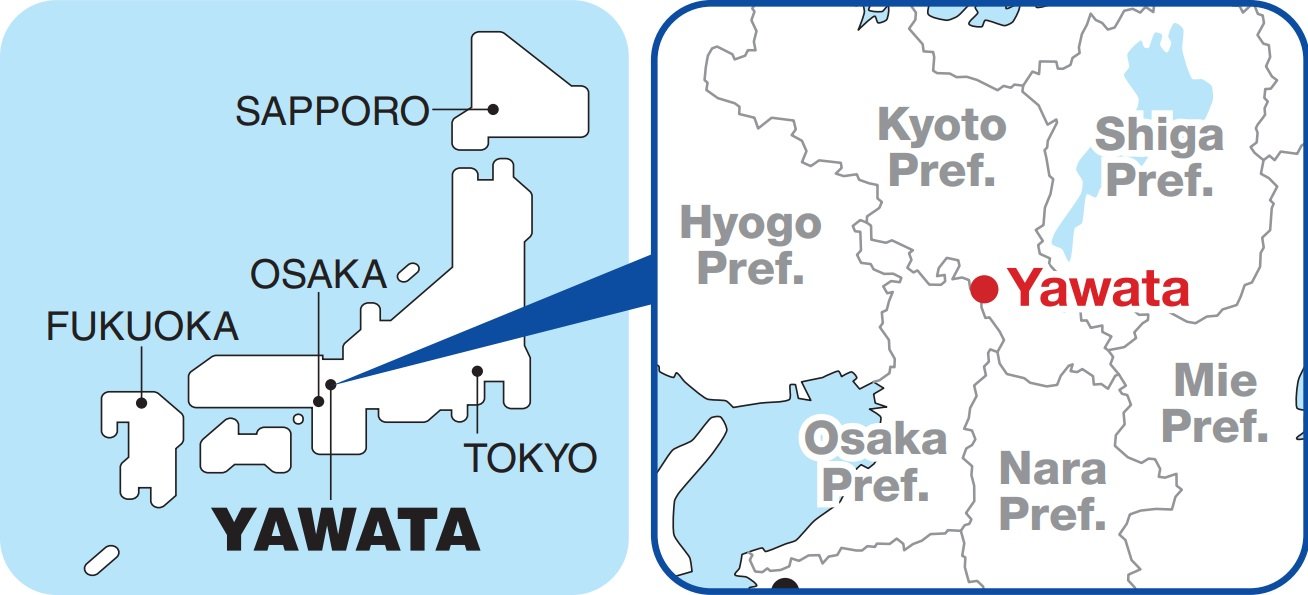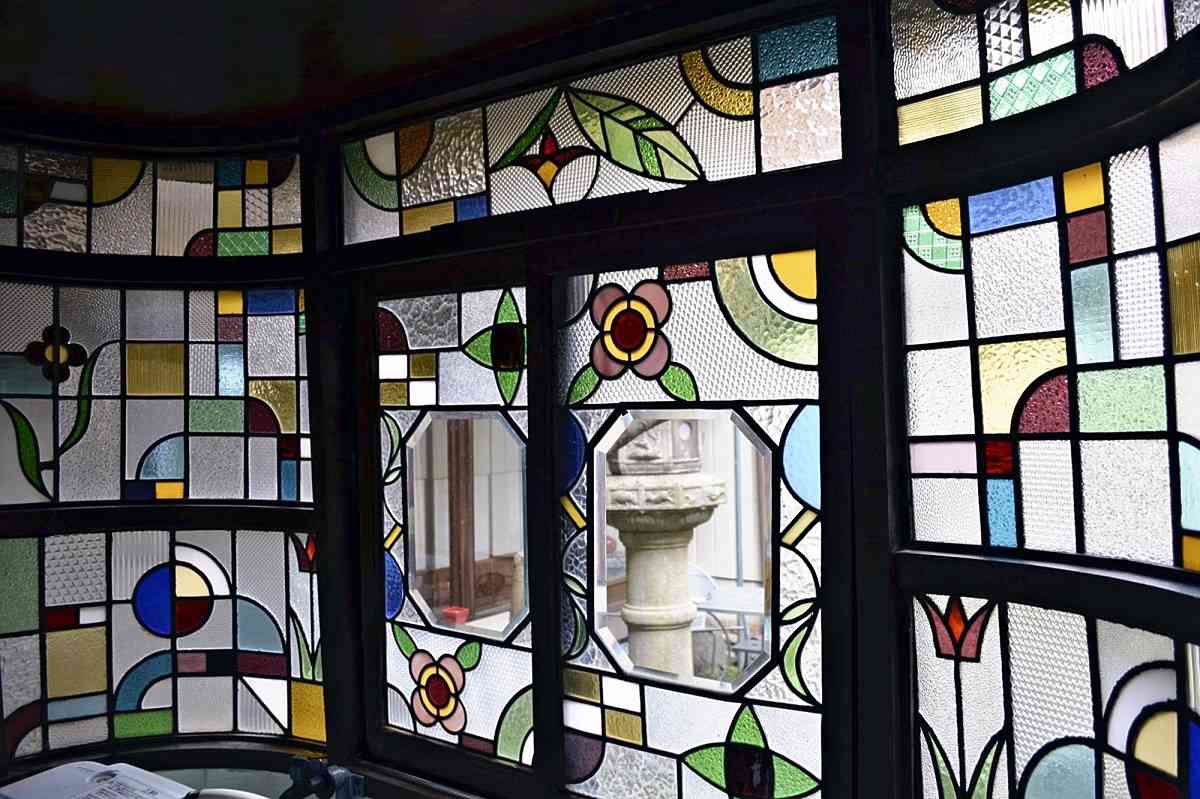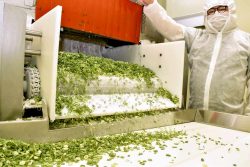
The streetscape of the former Hashimoto Yukaku is seen in Yawata, Kyoto Prefecture. The district used to be crowded with brothels.
6:00 JST, April 16, 2023
YAWATA, Kyoto — A quarter that once flourished as a red-light district in southern Kyoto Prefecture now attracts tourists from across Japan after former brothels were renovated into a ryokan Japanese-style inn and a coffee shop.
A woman from China who loves Japanese architecture became interested in the dilapidated houses and bought them to open them to the public. These houses are symbols of a dark history for the community, so local people are cautious about turning them into tourist attractions, even while saying the truth should be passed on.
From the 16th century on, red-light districts — yukaku in Japanese — began to be created in various places across the country, including Kyoto, Osaka and Edo, now Tokyo. During the Tokugawa period, yukaku paid large sums of money to the shogunate. In 1872, the central government banned forced prostitution and human trafficking, but to no avail because it did not present any aid to the women who would otherwise have lost their livelihood.
That was why yukaku continued to exist in Japan until 1956, when the anti-prostitution law was enacted to punish prostitution agencies and protect women. Half a century after this law went into force, townscapes with brothels continue to disappear.

Hashimoto Yukaku in Yawata, Kyoto Prefecture, had 86 brothels in 1937, according to a historic document. It is said about 680 people were working to entertain customers from Osaka and other areas and that the money paid by the yukaku accounted for one-third of Yawata’s local tax revenues.
Brothel to ryokan
In 2019, Rika Masakura, a 58-year-old woman originally from China, bought one of the former brothel houses that had not found a buyer. The two-story wooden structure, which was constructed before World War II, was richly decorated with elegant stained glass and tiles. When she bought it, however, the garden was in disrepair, the walls were crumbling and the ceiling was leaking.

Stained glass is a reminder of when the building was used as a brothel.
Masakura renovated it and opened it as an inn the following year. She then bought another former brothel nearby and turned it into a coffee shop. She got the funds for this by selling her condominium in Osaka Prefecture and her house in China, as well as through crowdfunding.

A dressing table with a mirror and chair that was used when the brothel was in operation
Born and raised in northeastern China, where many Japanese used to live before and during the war, Masakura admired the Japanese architecture that remained there. Unlike the concrete housing complexes where Chinese people were living, the stylish wooden houses had indoor staircases. “I’d envied the people who were living there,” she said.
Since Masakura began giving tours of her renovated buildings, more than 100 tourists and researchers each month have visited the houses.
Mixed sentiments
In the Hashimoto Yukaku district, the townscape of the red-light district is being replaced by ordinary houses and parking lots. There is little momentum among locals to preserve the old buildings.
In fact, the opposite is true. A stone monument marking the site of a brothel in the district was removed during the city’s redevelopment at the request of many residents.
“There is no need to remind our children of the past,” a 79-year-old woman who grew up in the district said. Descendants of the former brothel owners still live in the community, and this woman is one of them.
“Some residents don’t want people to know about it.”
Back then, daughters of poor families were sold to brothels. The woman remembers that she could not talk about her family business when she was in junior high school. She remembers asking her father many times why he began the business, only to be told, “To make a living.”
“I don’t like the idea of having such a history left in a tangible form.”
However, the woman also participates in walking tours in the district and tells tourists stories of her background and how she feels about the brothels, when they are interested in such stories.
“Human trafficking used to be allowed in Japan,” she said. “There were people who had no choice but to live in this way. I think that fact should be remembered.”
The Yawata city government is proceeding with redevelopment projects in the surrounding area, but there are no plans to preserve the streetscape of the former yukaku. Mayor Fumiaki Horiguchi said that the preservation will be difficult “unless the local community makes the request.”
No historical evaluation
According to prewar statistics, there were more than 500 yukaku, or red-light districts, throughout Japan in the early 20th century, and about 52,000 prostitutes. Among owners of former brothel houses, the trend has been to demolish the buildings rather than to preserve them as part of a dark history.
What makes it difficult to preserve and study yukaku history?
Kanazawa University Prof. Akira Ide said it is partly because there is no established opinion on the cultural heritage of these districts. Ide is an expert in tourism, especially “dark tourism,” which includes visiting locations with war damage and other negative historical sites.
“Even today, there are differences of opinion on how to view brothels and the sex industry,” Ide said. “Controversy arises when you try to preserve the brothels while talking only about the superficial facts.”
Ide said that people need to talk about brothels in a historical context, such as why modern society required prostitutes, as well as from the perspective of discrimination against women and human rights issues.
“The central government and specialized institutions such as universities should be involved in discussions on what to pass on to the next generation regarding the brothels and how that should be done.”
Related Tags
"Features" POPULAR ARTICLE
-

Sanrio to Open Museum in Yamanashi Pref. Dedicated to Founder, Exhibits Include Hello Kitty, Other Characters
-

Autumn Foliage Surrounds Visitors to Tokyo’s Showa Kinen Park
-

My Daughter No Longer Speaks to Me, But I Want to See Her and My Grandchild
-

Kumamoto: Public Bath Refurbished as Library Where You Can Chat, Take Photos
-

Frozen Vegetables: Demand Rises for Convenient, Tasty Domestic Produce
JN ACCESS RANKING
-

Tokyo Economic Security Forum to Hold Inaugural Meeting Amid Tense Global Environment
-

Keidanren Chairman Yoshinobu Tsutsui Visits Kashiwazaki-Kariwa Nuclear Power Plant; Inspects New Emergency Safety System
-

Imports of Rare Earths from China Facing Delays, May Be Caused by Deterioration of Japan-China Relations
-

University of Tokyo Professor Discusses Japanese Economic Security in Interview Ahead of Forum
-

Japan Pulls out of Vietnam Nuclear Project, Complicating Hanoi’s Power Plans

























